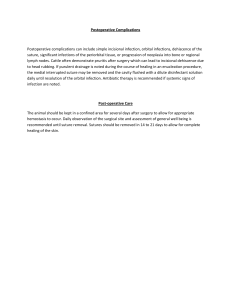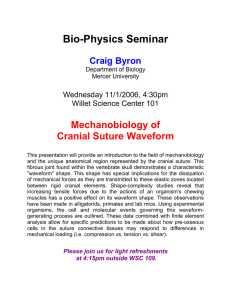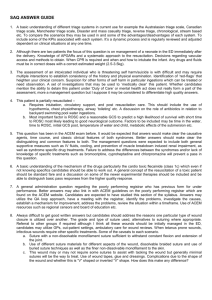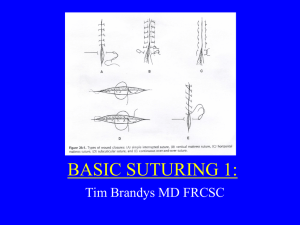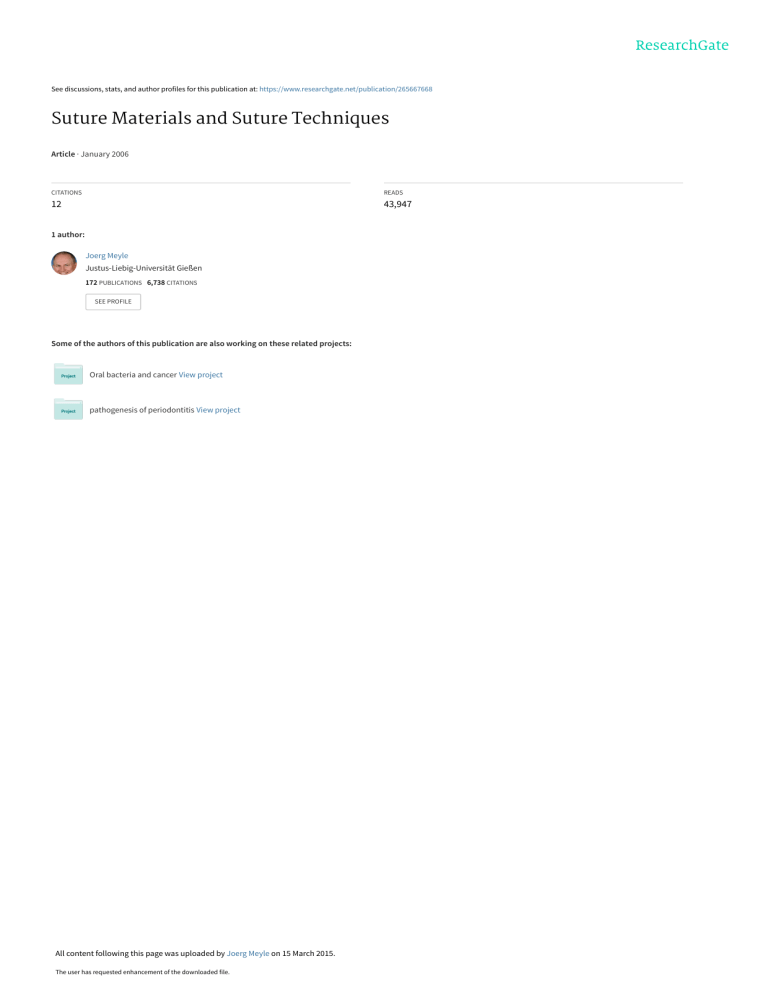
See discussions, stats, and author profiles for this publication at: https://www.researchgate.net/publication/265667668 Suture Materials and Suture Techniques Article · January 2006 CITATIONS READS 12 43,947 1 author: Joerg Meyle Justus-Liebig-Universität Gießen 172 PUBLICATIONS 6,738 CITATIONS SEE PROFILE Some of the authors of this publication are also working on these related projects: Oral bacteria and cancer View project pathogenesis of periodontitis View project All content following this page was uploaded by Joerg Meyle on 15 March 2015. The user has requested enhancement of the downloaded file. opyrig by ht Qu C All eR ech FOCUSte ARTICLES vo rbe ha lte n n t es i Suture Materials and Suture Techniques se nz Jörg Meyle This article provides a brief outline of the suture materials used in periodontal surgery and their properties. Success of surgical treatment depends on achieving primary wound healing, particularly with demanding surgical techniques – especially in relation to regenerative methods. Choosing the right material in combination with the appropriate technique is the cornerstone of treatment success. Key words: flap approximation, needle holder, primary wound healing, secondary wound healing, surgical knot technique, suture materials, suture techniques INTRODUCTION A good healing result following either a surgical procedure or a traumatic lesion relies on precise approximation of the wound edges and their fixation to the surrounding tissue, in other words immobilisation of the wound area. Some of the aids for this purpose, in the form of suture materials and needles, have been in use for centuries. In conjunction with the advances in surgical techniques, the importance of optimal wound care and suture fixation has greatly increased in recent years. In an impressive experimental article, Burkhardt and Lang (2005) reported on the advantages of microsurgical techniques in the context of plastic-aesthetic surgery. As they showed in their study, perfect microsurgical tissue approximation leads to early and rapid revascularisation, which not only speeds up wound healing but also promotes successful treatment (Burkhardt and Lang, 2005). Apart from plastic-aesthetic corrections, perfect wound care and suture approximation are extremely important in regenerative methods and in connection with implantation (Christgau, 2001; Wachtel et al, 2003). The aim is always to achieve primary wound healing. Perio 2006; Vol 3, Issue 4: 253–268 This article gives a brief outline of the most common suture materials and suture techniques and their application in relation to treatment measures used in periodontal surgery. WOUND HEALING A distinction is made between primary (per primam intentionem) and secondary (per secundam intentionem) wound healing. Primary wound healing is characterised by excellent approximation of the wound margins with a minimal haematoma, which is found in the wound gap and becomes organised and is absorbed in the days following release of growth and healing mediators. Organisation of this blood clot is triggered by cytokines, which are released from the activated platelets and include platelet-derived growth factor (PDGF), epidermal growth factor (EGF), insulin-like growth factor (IGF) and TGF-β (transforming growth factor-β). In addition, it is known that, after blood clotting in serum, high activity of interleukin-1 receptor antagonists (IL-1 RA) can be detected, which also blocks pro-inflammatory reactions (Busti et al, 2005). It has recently been shown that derivatives of arachi253 Meyle · Suture Materials and Suture Techniques Qu i nt vo rbe ha lte n e ss e n z Fig 1 Atraumatic suture materials. Needles with threeeighths of a circle curvature and a relatively large radius, combined with thread sizes of 6/0 or 7/0, are typically used in periodontal surgery. Fig 2 Surgical needle with the typical elements: triangular tip, needle body (square and swaged at the end into which the thread is fitted). The correct way to hold the needle is not at the end or at the tip, but in the area of the needle body. donic acid metabolism, such as lipoxins and resolvins, are extremely important in wound healing (Kantarci et al, 2006). They deactivate granulocytes and activate macrophages, which then act as cleaning and eliminating cells; in other words, they have no inflammatory activities. The effects of these diverse, locally acting cytokines are the budding and formation of new capillaries, the migration of fibroblasts and the rapid proliferation and migration of keratinocytes on the wound surface so that surface epithelialisation starts within a few days, closing the wound to the outside and restoring ectodermal integrity. In secondary wound healing, by contrast, the wound margins gape a great deal, the healing processes take place far more slowly and are characterised by heavy exudation and signs of inflammation, which are caused by contamination of the wound. Consequently epithelial wound closure is delayed and distinct scarring can be seen as a result of healing. Under certain circumstances, this scarring may involve massive keloid formation, depending on the localisation and the predisposition of the individual (Kumar et al, 2003). In periodontal surgery, secondary wound healing always puts treatment success at acute risk because deeper tissue layers are eventually altered by inflammation. This at least delays, if not entirely excludes, complete healing or restoration of the lost periodontium. The aim of all surgical efforts, particularly in the context of regenerative or plasticaesthetic measures, must be to achieve undisturbed healing with primary wound closure. Taking aseptic precautions is one of the most important requirements. It has been demonstrated in various studies that, after removal and microbiological work-up of suture materials that had remained in the patient’s mouth for seven or 14 days, acne bacteria could be cultured from these materials (Slots et al, 1999). As these pathogens are only found on the outer skin, this proves that the thread material had contact with the skin surface during the course of wound care and contamination with these bacteria thus took place (Nowzari et al, 1995). Even given the best conditions, sterile circumstances cannot be achieved in periodontal surgery during and after the procedure as it is performed in the bacterially contaminated oral cavity. Taking aseptic precautions should help to ensure that no foreign organisms from outside, i.e. from the outer surface of the patient’s body, from other objects or from the surgeon or nurse, unintentionally enter the patient’s mouth and penetrate the wound. Despite the fact that asepsis is not possible in the oral cavity, it is nevertheless very important to ensure that working is as clean and sterile as possible. 254 by ht opyrig C All eR ech te SHAPE AND SIZE OF NEEDLES In contrast to other surgical fields, the situation in periodontal surgery is characterised by one distinctive feature: because of the length of the interdental spaces, particularly between the posterior teeth, long, large-radius needles are required which can Perio 2006; Vol 3, Issue 4: 253–268 opyrig Qu by ht Meyle · C All eR ech ev Suture Materials and Suture tTechniques orb eh alt en n i t es se nz Figs 3b and 3c Triangular needle tip with reverse cutting edge. Apart from the two outer edges, the middle edge of the outer curvature also cuts – unlike normal needles where the third cutting edge is located in the inner curvature. Fig 3a Different types of needle (left to right): pointed triangular needle, pointed needle with reverse cutting edge, rounded needle tip (not usual in dentistry). easily be grasped again after being introduced into the interdental space on the opposite side. At the same time, it is important that these needles are available with small-sized threads (6/0, 7/0). Needles that describe three-eighths of a circle are particularly suitable for this purpose (Figs 1 and 2). It is important that the needles have a triangular cross-section at their tip (Figs 3a to 3c). This makes it easier to insert the needle and pass it through the tissue because the needle cuts through the tissue with its two outer cutting edges. The third cutting edge is formed by the outer curvature. This contrasts with the normal needle shapes where this edge is found in the concave area, in other words on the inner curvature. Hence the term reverse-cutting needle is used in this respect. As a result of this configuration, a cut is produced that provides vertical relief and does not lead to immediate dehiscence (Figs 4a and 4b). The same type of needle with a far smaller radius is used to make cuts on the buccal or lingual/ palatal side. Table 1 lists the thread sizes (based on thickness) and the corresponding diameters. SUTURE MATERIALS The choice of suture material is one of the decisive factors in how successful the overall surgical treatment is. As a basic principle, atraumatic suture materials are used for periodontal surgery. In these operations, needle and thread form a single unit so that the tissue is not additionally traumatised as it is punctured and Perio 2006; Vol 3, Issue 4: 253–268 Table 1 List of common thread sizes, as indicated in the United States Pharmacopoeia (USP) and European Pharmacopoeia (EP). USP size code EP size code (mm) Diameter range (mm) 12/0 0.01 0.001–0.009 11/0 0.1 0.010–0.019 10/0 0.2 0.020–0.029 9/0 0.3 0.030–0.039 8/0 0.4 0.040–0.049 7/0 0.5 0.050–0.069 6/0 0.7 0.070–0.099 5/0 1.0 0.100–0.149 4/0 1.5 0.150–0.199 3/0 2.0 0.200–0.249 2/0 2.5 0.250–0.299 1/0 3.0 0.300–0.349 0 3.5 0.350–0.399 1 4.0 0.400–0.499 2 5.0 0.500–0.599 3 6.0 0.600–0.699 5 7.0 0.700–0.799 6 8.0 0.800–0.899 7 9.0 0.900–0.999 255 Meyle · Suture Materials and Suture Techniques Qu n Nature and properties of suture material Owing to the properties of the suture material, varying degrees of colonisation and biofilm formation on the surface of the thread take place within a few hours post-operatively. This can only be avoided by careful disinfection. As mechanical cleaning is not possible in the first few weeks following many difficult operative procedures, the wound area and sutures can only be kept clean by rinsing daily with a 0.1% chlorhexidine solution with/without peroxide solution (3%). It is also advisable to wipe the ends of the sutures with cotton buds previously soaked in chlorhexidine solution. 256 vo rbe ha lte n If the patient is not adequately covered duringt e the ss e n z operation, the threads are already contaminated after contact with the external skin and hence pathogens from the extra-oral area infiltrate the intraoral wound region. To avoid this, the face should be covered with sterile drapes and the facial skin disinfected. With respect to bacterial contamination and surface structure, monofilament materials are preferable to polyfilament suture materials (see Fig 6a). However, thicker threads made from monofilament material have wire-like properties so that the thread ends can cause injuries to the mucosal surface either in the area of the alveolar process or in the adjacent cheek area. For this reason, monofilament polymer threads can only be used in smaller sizes (6/0, 7/0, 8/0, etc.). When thicker threads are required, either Teflon threads or polyfilament suture materials should be used. Unlike monofilament materials, polyfilament materials have a capillary effect. This leads to pathogens and saliva rapidly being soaked up, an effect that cannot be prevented even with covered polyfilament threads. i the thread is passed through (Figs 1 and 5). A distinction is made between absorbable and nonabsorbable materials. The absorbable materials are often polymers or copolymers of lactic acid with glycolic acid, which are processed in different proportions and various molecular forms to produce synthetic threads (Figs 6a to 6i). The most wellknown material, Vicryl®, is made of polyglycolic acid and polylactide in a mixing ratio of 9:1, which is why it is also known as polyglactin 910. The mixing ratio and the molecular arrangement of the individual components determine the mechanical properties of the polymer and its absorption and degradation time. Absorbable materials of animal origin (catgut), which are obtained from bovine gut or sheep gut for instance, should not be used nowadays for safety reasons. The advantage of absorbable materials is that they are glycolysed or dissolved, and they are broken down with almost no residues by natural metabolic processes. If the molecules are hydrophobic, their hydrolysis is delayed and their absorption time is lengthened. Non-absorbable materials can be divided into polymers, silks and Teflon (expanded polytetrafluoroethylene) materials, which are commonly used in periodontal surgery. In various animal experiments in previous years, the study group led by Selvig analysed the tissue reactions to various absorbable or non-absorbable suture materials (Leknes et al, 2005). Interestingly, rapid bacterial contamination of the puncture canal was found in the oral cavity with all the materials; this was partly accompanied by an intense inflammatory reaction and partly by epithelialisation of the puncture canal. This happened irrespective of whether the suture was placed in the area of the lining mucosa or the masticatory mucosa (Selvig et al, 1998). by ht opyrig C All eR ech te KNOT TECHNIQUES As atraumatic suture material only is used for periodontal surgery, the ends of the threads are knotted with the aid of the needle holder or possibly anatomical forceps for very thin sutures (7/0). Among the various types of knots that can be used, three are of greater importance: • the surgeon’s knot • the square knot (or reef knot) and • the sliding knot. The standard knot is the surgeon’s knot, in which the thread is looped not once but twice around the shaft of the needle holder, then the end of the thread is pulled through this double loop; then a simple reverse loop is made, which blocks the first knot (Figs 7a to 7o). In many cases a third knot is tied in the opposite direction to the second knot to make it even more secure. In the case of a square knot, the two ends of the thread are joined together by looping once around the needle holder. In other words, the shaft of the needle holder is placed on the thread, the thread is wound once around the needle holder, and then the end of the thread is grasped Perio 2006; Vol 3, Issue 4: 253–268 opyrig Qu by ht Meyle · C All eR ech ev Suture Materials and Suture tTechniques orb eh alt en n i t es se nz Figs 4a and 4b Model of passing a surgical needle with reverse cutting edge through the gingival tissue. As a result of the reverse cutting edge, the soft tissue is better able to withstand mechanical tension so that the risk of dehiscence is reduced. Fig 5 Needle swaged at the end to hold the thread. Fig 6a Different suture materials. From left to right: Teflon thread (ePTFE), monofilament polypropylene thread, polyfilament Vicryl suture, polyfilament polyester suture, catgut, silk (braided). Fig 6b Macro-image of monofilament polypropylene. Fig 6c Scanning electron microscopic image of the material from Fig 6b. Perio 2006; Vol 3, Issue 4: 253–268 257 Meyle · Suture Materials and Suture Techniques Qu i nt vo rbe ha lte n e ss e n z Fig 6d Macro-image of braided Vicryl. Fig 6e Scanning electron microscopic image of the material from Fig 6d. Fig 6f Polyfilament braided polyester material. Fig 6g Scanning electron microscopic image of the material from Fig 6f. Fig 6h Teflon thread. Fig 6i Scanning electron microscopic image of the material from Fig 6h. 258 by ht opyrig C All eR ech te Perio 2006; Vol 3, Issue 4: 253–268 opyrig Qu by ht Meyle · C All eR ech ev Suture Materials and Suture tTechniques orb eh alt en n t es i Figs 7a to 7n Instrument tie (surgeon’s knot), starting with the initial position. a b c d se nz Fig 7a The needle holder is placed on the end of the thread. Figs 7b and 7c One thread is looped twice around the needle holder... Figs 7d to 7h ...then the other end of the thread is grasped and pulled through. with the needle holder and pulled through this loop. The second knot is tied in the opposite direction, which means the needle holder is now placed under the thread and looped around once, then the end of the thread is again pulled through the loop. This knot does not provide adequate security, particularly with suture materials that have a totally flat surface (monofilament threads), so that loosening is a possibility (Figs 8a and 8b). The sliding knot resembles the square knot in that the thread is looped around the needle once, but the two knots run in the same direction, so that the needle holder is laid on the thread each time. This leads to a certain instability, even after the ends of the thread have been tightened. If working with very fine suture materials (sizes > 6/0), it is advisable to use fine anatomical forceps for knotting instead of the needle holder. Fine suture materials sometimes get hooked in the limbs of the needle holder. Perio 2006; Vol 3, Issue 4: 253–268 SUTURE TECHNIQUES The basic aim with a simple interrupted suture is to unite tissue areas adjacent to the two lips of the wound. The distance from the puncture point to the edge of the wound should be the same as the distance from the needle exit point to the wound margin. The puncture depth should also be the same at both wound edges (Figs 9a to 9h). After tooth extractions, an overlying, crossed-over mattress suture can be placed in order to approximate the wound edges (Figs 10a and 10b). In periodontal surgery, the interdental simple interrupted suture is the standard method for wound closure as part of a flap operation (modified Widman flap) (Figs 11a to 11d). In many cases this leads to the post-operative formation of craters (Figs 12a and 12b), which can only be avoided by altering the flap and suture technique. Apart from flap mobilisation in the form of a split flap or periosteal incision, recommended improvements 259 Meyle · Suture Materials and Suture Techniques Qu i nt Figs 7a to 7n Instrument tie (surgeon’s knot), starting with the initial position. e f g h i j 260 vo rbe ha lte n e ss e n z Figs 7d to 7h ...then the other end of the thread is grasped and pulled through. Figs 7i to 7j The end of the thread is then laid on the needle holder, looped once around the needle holder... have included preparing a (modified) papilla preservation flap in the interdental area or a simplified papilla preservation flap (Takei et al, 1985; Cortellini et al, 1995). Compared with the traditional modified Widman flap operation, these techniques are far more time-consuming, demand considerable surgical skill, and require an inflammationfree gingiva. With this flap preparation technique, approximation needs to be carried out using several stitches in order to achieve good revascularisation as by ht opyrig C All eR ech te early as possible. This has led to the use of microsurgical suture techniques with the finest materials (6/0, 7/0) so that the wound edges can be approximated as perfectly as possible (Figs 13a to 13d). In order to improve interdental soft tissue approximation, vertical mattress sutures in combination with a simple interrupted suture (also known as ‘Laurell’s suture’) have been proposed and have proved successful in clinical use (Figs 14a and 14b) (Laurell et al, 1998). Perio 2006; Vol 3, Issue 4: 253–268 opyrig Qu by ht Meyle · C All eR ech ev Suture Materials and Suture tTechniques orb eh alt en n i t es k l m n se nz Figs 7k and 7l ... then the other end is pulled through as before. Fig 7m The result is a surgeon’s knot... Fig 7n ...with the typical pattern. Fig 8a Loose knot. Fig 8b The knot is tightened. In relation to microsurgical, minimally invasive operation techniques and mobilisation of a papilla preservation flap or the modified papilla preservation flap, a combination of different sutures is advantageous for wound stabilisation. According to Cortellini et al (1999), not only wound stabilisa- tion but also good approximation of the soft tissue is achieved by using so-called supporting sutures. As a result, the fine interdentally placed sutures to unite the two edges of the wound simply provide tissue approximation but they do not have to withstand any mechanical tension (Cortellini et al, Perio 2006; Vol 3, Issue 4: 253–268 261 Meyle · Suture Materials and Suture Techniques Qu i nt Figs 9a to 9h Simple interrupted suture on phantom flesh. Fig 9a Wound to be stitched. c Fig 9b Passing the needle through two lips of the wound at the same distance from the edge of the incision... d f Figs 9e and 9f Then the ends of the thread are joined together using a surgeon’s knot. 262 vo rbe ha lte n e ss e n z Figs 9c and 9d ...and to the same depth. e by ht opyrig C All eR ech te Perio 2006; Vol 3, Issue 4: 253–268 opyrig Qu by ht Meyle · C All eR ech ev Suture Materials and Suture tTechniques orb eh alt en n i t es Fig 9g The knot is tightened. a se nz Fig 9h The ends of the thread are trimmed. b Figs 10a and 10b Approximation of the wound edges after tooth extraction by overlying, crossed-over mattress stitch. 1999). Consequently the delicate interdental tissue is relieved of direct mechanical tension and any collapse of the capillaries is prevented. Otherwise, the blood flow in these sensitive tissue segments would deteriorate further (Figs 15a to 15c). These so-called ‘off-set sutures’ are supported on the available interdental bone; if this is absent, support must be provided via a titanium-reinforced membrane, which in turn is fixed on a spacer, for example a screw. By means of support on this hypomochlion, the two mobilised flaps (buccal and oral) after periosteal incision or the prepared split flaps are mobilised in a cranial direction and the wound Perio 2006; Vol 3, Issue 4: 253–268 edges alone are approximated by the supporting sutures (Figs 16a and 16b, 17a to 17e). If connective tissue grafts are harvested, there is a possibility in the palatal area of closing the wound with horizontal crossed-over mattress stitches looped around the adjacent teeth, or by direct local wound closure in the form of a continuous suture (Böhm et al, 2005). In this case, considerable dehiscence can arise if the knot becomes loosened (Fig 18). Externally placed interdental sutures have been described for coronal or apical flap advancement, which make corresponding soft tissue movement possible (Silverstein, 1999). Fixation of a split flap 263 Meyle · Suture Materials and Suture Techniques Qu i nt Figs 11a to 11d Principle of the interdental simple interrupted suture in flap surgery. Fig 11a Fig 11b Fig 11c Fig 11d a b c d 264 vo rbe ha lte n e ss e n z Penetration of the buccal wound lip. Passing the needle through the interdental space and penetration through the lingual/oral lip of the wound. Passing the thread back onto the buccal side below the contact point. Knotting on the buccal side and trimming the thread ends. Fig 12a Clinical example of the interdental simple interrupted suture after modified Widman flap. by ht opyrig C All eR ech te Fig 12b Four weeks after the surgical operation, there is distinct crater formation at the treated sites. Perio 2006; Vol 3, Issue 4: 253–268 opyrig Qu by ht Meyle · C All eR ech ev Suture Materials and Suture tTechniques orb eh alt en n i t esimple Figs 13a to 13d Modified papilla preservation flap interdentally between teeth 36 and 37. Fixation with three ss e n z interrupted sutures (size 6/0). Fig 13a Post-operative situation. Fig 13b Seven days after the operation. Fig 13c Two weeks after the procedure. Fig 13d Clinical situation 4 weeks after the surgical operation. Figs 14a and 14b Principle of the vertical mattress suture in combination with a simple interrupted suture in the interdental area: firstly a vertical mattress suture is stitched from buccally to orally above the edge of the bone and below the contact point. This is not knotted at first, but the thread is looped once around the thread end on the buccal side using the needle, then it is passed through the interdental space above the gingiva and below the contact point onto the oral side, where it is passed through the visible loop between the two puncture points. The thread then follows the interdental space again below the contact point onto the buccal side where it is knotted. Perio 2006; Vol 3, Issue 4: 253–268 265 Meyle · Suture Materials and Suture Techniques Qu n by ht opyrig C All eR ech te vo rbe ha lte n i t es Figs 15a to 15c Principle of the interdental supporting suture for coronal advancement of the wound edges and stabilisase nz tion of the periodontal tissue. Figs 15a and 15b Starting from the buccal wound, which is penetrated apical to the highest lying interdental bone, the suture material is taken along the upper edge of the bone to the oral side, where it perforates the soft tissue apical to the supporting bone. The local bony situation gives rise to various support points (blue arrows), with which it is possible to move the two wound edges in a cranial direction, provided they were mobilised beforehand by periosteal incision or provided a split flap is being used. Fig 15c Status following suturing and additional approximation of the wound edges with a simple interrupted suture. Fig 16a Clinical example of an internally crossed-over mattress suture (supporting suture) for approximation and stabilisation of the wound edges as part of guided bone regeneration (GBR) before implantation. 266 Fig 16b Status after complete suturing with simple interrupted stitches. Perio 2006; Vol 3, Issue 4: 253–268 opyrig Qu by ht Meyle · C All eR ech ev Suture Materials and Suture tTechniques orb eh alt en n i t esurgery. Figs 17a to 17e Clinical example of supporting and simple interrupted sutures during regenerative periodontal ss e n z Fig 17a Pre-operative clinical situation. Fig 17b After exposure, a single-wall bony pocket is revealed. Fig 17c For re-approximation of the wound edges, a non-absorbable ePTFE suture is placed around the distal side of the adjacent tooth (see bone condition). Fig 17d Status after fixation of the wound edges with the aid of a mattress suture. Fig 17e Status following wound closure with additional simple interrupted sutures in the area of the wound edges. The suture material used was Teflon thread (Gore®, size: 5/0) for the supporting stitch and monofilament polypropylene (Prolene®, size: 6/0) for the interdental simple interrupted stitches. Fig 18 Continuous locking suture (thread size: 6/0) after harvesting of a connective tissue graft from the palate. Status at the time of suture removal (7 days in situ). Perio 2006; Vol 3, Issue 4: 253–268 267 Meyle · Suture Materials and Suture Techniques Qu nt i in a different vertical position can also be achieved by direct fixation to the underlying periosteum. If a distal wedge-shaped excision is made, it is often advisable to use not just a simple interrupted suture, which joins the two flap edges together, but also to combine this additionally with a looping stitch on the distal tooth so that the best possible sealing is achieved on the distal surface of the last molar. Careful tension-free suturing is one of the most important prerequisites for treatment success in the majority of operative procedures in periodontology. CONCLUSIONS In most cases, primary wound healing can be achieved by careful flap and suture technique, provided that the preceding treatment steps have been successfully completed. This is then evident as successful regeneration that is clinically measurable and visible on X-rays. Today’s suture materials and needles, together with the rest of the instrumentation used, make a decisive contribution to this success. REFERENCES Böhm S, Weng D, Meyle J. Bindegewebetransplantate in der Parodontalchirurgie. Parodontologie 2005;16:295–304. Burkhardt R, Lang NP. Coverage of localized gingival recessions: comparison of micro- and macrosurgical techniques. J Clin Periodontol 2005;32:287–293. Busti AJ, Hooper JS, Amaya CJ, Kazi S. Effects of perioperative anti-inflammatory and immunomodulating therapy on surgical wound healing. Pharmacotherapy 2005;25: 1566–1591. Christgau M. Die parodontale Wundheilung – Klinische Erfahrung mit regenerativen Therapiemethoden. Parodontologie 2001;12:373–396. Cortellini P, Pini-Prato G, Tonetti M. The modified papilla preservation technique. A new surgical approach for interproximal regenerative procedures. J Periodontol 1995; 66:261–266. 268 View publication stats by ht opyrig C All eR ech te vo rbe ha lte n e ss e n z Cortellini PP, Pini-Prato G, Tonetti MS. Vereinfachte Lappengestaltung zur Erhaltung der Papillen. Eine neue chirurgische Technik zur Behandlung des Weichgewebes bei regenerativen Verfahren. Int J Par Rest Zahnheilkd 1999;19:569–579. Kantarci A, Hasturk H, van Dyke TE. Host mediated resolution of inflammation in periodontal diseases. Periodontology 2000 2006;40:144–163. Kumar V, Cotran RS, Robbins SL. Basic Pathology. 7th edition. Philadelphia: Saunders, 2003. Laurell L, Gottlow J, Zybutz M, Persson R. Treatment of intrabony defects by different surgical procedures. A literature review. J Clin Periodontol 1998;69:303–313. Leknes KN, Roynstrand IT, Selvig KA. Human gingival tissue reactions to silk and expanded polytetrafluorethylene sutures. J Periodontol 2005;76:34–42. Nowzari H, Matian F, Slots J. Periodontal pathogens on polytetrafluoroethylene membranes for guided tissue regeneration inhibit healing. J Clin Periodontol 1995;22:469–474. Selvig KA, Biagiotti GR, Leknes KN, Wikesjo UM. Oral tissue reactions to suture materials. Int J Periodontics Restorative Dent 1998;18:474–487. Silverstein LH. Principles of dental suturing. The complete guide to surgical closure. Mahwah, USA: Montage Media Corp, 1999. Slots J, MacDonald ES, Nowzari H. Infectious aspects of periodontal regeneration. Periodontology 2000 1999;19: 164–172. Takei HH, Han TJ, Carranza FA Jr et al. Flap technique for periodontal bone implants. Papilla preservation technique. J Periodontol 1985;56:204–210. Wachtel H, Schenk G, Böhm S et al. Microsurgical access flap and enamel matrix derivative for the treatment of periodontal intrabony defects: a controlled clinical study. J Clin Periodontol 2003;30:496–504. Reprint requests: Prof Dr med dent Jörg Meyle Zentrum für Zahn-, Mund- und Kieferheilkunde Poliklinik für Parodontologie Schlangenzahl 14 35392 Giessen Germany Email: joerg.meyle@dentist.med.uni-giessen.de Originally published (in German) in Parodontologie 2006;17(2):91–96 Perio 2006; Vol 3, Issue 4: 253–268



